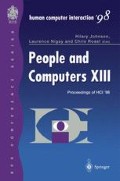Abstract
Personification of interface agents has been speculated to have several advantages, such as a positive effect on agent credibility and on the perception of learning experience. However, important questions less often addressed so far are what effect personification has on more objective measures, such as comprehension and recall, and furthermore, under what circumstances this effect (if any) occurs. We performed an empirical study with adult participants to examine the effect of the Ppp Persona not only on subjective but also on objective measures. In addition, we tested it both with technical and non-technical domain information. The results of the study indicate that the data from the subjective measures support the so called persona effect for the technical information but not for non-technical information. With regard to the objective measures, however, neither a positive nor a negative effect could be found. Implications for software development are discussed.
Access this chapter
Tax calculation will be finalised at checkout
Purchases are for personal use only
Preview
Unable to display preview. Download preview PDF.
References
André, E., Rist, T. (1996), Coping with Temporal Constraints in Multimedia Presentation Planning, in Proceedings of AAAI-96, Vol. 1, MIT Press, pp. 142–7.
André, E., Müller, J., Rist, T. (1996), The PPP Persona: A Multipurpose Animated Presentation Agent, in T. Catarci, M. Costabile, S. Levialdi, G. Santucci (eds.), Advanced Visual Interfaces, ACM Press, pp. 245–7.
Ball, G., Ling, D., Kurlander, D., Miller, J., Plugh, D., Skelly, T., Stankosky, A., Thiel, D., Dantzich, M. V., Wax, T. (1997), Lifelike Computer Characters: The Persona Project at Microsoft Research, in J. M. Bradshaw (ed.), Software Agents, MIT Press, pp.191–222.
Hegarty, M., Just, A. (1993), “Constructing Mental Models of Machines from Text and Diagrams”, Journal of Memory and Language 32, 717–742.
Hegarty, M., Just, M. A., Morrison, I. R. (1988), “Mental Models of Mechanical Systems: Individual Differences in Qualitative and Quantitative Reasoning”, Cognitive Psychology 20, 191–236.
Jellinek, H. (1996), Animator v1.8, Animation tool available via http://www.java.sun.com/applets/Animator
Koda, T., Maes, P. (1996), Agents with Faces: The Effect of Personification, in Fifth IEEE International Workshop on Robot and Human Communication (RO-MAN’96), IEEE Computer Society Press, pp. 189–94.
Lester, J. C., Stone, B. A. (1997), Increasing Believability in Animated Pedagogical Agents, in Proceedings of the First International Conference on Automomous Agents, ACM Press, pp. 16–21.
Lester, J. C., Converse, S. A., Kahler, S. E., Barlow, S. T., Stone, B. A., Bhogal, R. S. (1997a), The Persona Effect: Affective Impact of Animated Pedagogical Agents, in S. Pemberton (ed.), Proceedings of CHI’97: Human Factors in Computing Systems, ACM Press, pp. 359–66.
Lester, J. C., Stone, B. A., Converse, S. A., Kahler, S. E., Barlow, S. T. (1997b), Animated Pedagogical Agents and Problem-solving Effectiveness: A Large-Scale Empirical Investigation, in Proceedings of the Eighth World Conference on Artificial Intelligence in Education, IOS Press, pp. 23–30.
Nass, C., Steuer, J., Tauber, E. R. (1994), Computers are Social Actors, in B. Adelson, S. Dumais, J. Olson (eds.), Proceedings of CHI’94: Human Factors in Computing Systems, ACM Press, pp. 72–7.
Rickel, J., Johnson, W. L. (1997), Intelligent Tutoring in Virtual Reality: A Preliminary Report, in B. du Boulay, R. Mizoguchi (eds.), Proceedings of the Eighth World Conference on Artificial Intelligence in Education, IOS Press, pp. 294–301.
Rist, T., André, E., Müller, J. (1997), Adding Animated Presentation Agents to the Interface, in J. Moore, E. Edmonds, A. Puerta (eds.), Proceedings of the 1997 International Conference on Intelligent User Interfaces, ACM Press, pp. 79–86.
Salomon, G. (1984), `Television is `Easy’ and Print is `Tough’: The Differential Investment of Mental Effort in Learning as a Function of Perceptions and Attribution“, British Journal of Educational Psychology 76 (4), 647–658.
Sproull, L., Subramani, M., Kiesler, S., Walker, J. H., Waters, K. (1996), “When the Interface is a Face”, Human-Computer Interaction 11, 97–124.
Takeuchi, A., Naito, T. (1995), Situated Facial Displays: Towards Social Interaction, in I. Katz, R. Mack, L. Marks, M. B. Rosson, J. Nielsen (eds.), Proceedings of CHI’95: Human Factors in Computing Systems, ACM Press, pp. 450–5.
Towns, S. G., Callaway, C. B., Voerman, J. L., Lester, J. C. (1998), Coherent Gestures, Locomotion, and Speech in Life-like Pedagogical Agents, in Proceedings of the 1998 International Conference on Intelligent User Interfaces, ACM Press, pp. 13–20.
Walker, J. H., Sproull, L., Subramani, R. (1994), Using a Human Face in an Interface, in B. Adelson, S. Dumais, J. Olson (eds.), Proceedings of CHI’94: Human Factors in Computing Systems, ACM Press, pp. 85–91.
Weidenmann, B. (1988), Psychische Prozesse beim Verstehen von Bildern (trans. Psychological Processes in Picture Understanding),Hans Huber.
Author information
Authors and Affiliations
Editor information
Editors and Affiliations
Rights and permissions
Copyright information
© 1998 Springer-Verlag London
About this paper
Cite this paper
van Mulken, S., André, E., Müller, J. (1998). The Persona Effect: How Substantial Is It?. In: Johnson, H., Nigay, L., Roast, C. (eds) People and Computers XIII. Springer, London. https://doi.org/10.1007/978-1-4471-3605-7_4
Download citation
DOI: https://doi.org/10.1007/978-1-4471-3605-7_4
Publisher Name: Springer, London
Print ISBN: 978-3-540-76261-4
Online ISBN: 978-1-4471-3605-7
eBook Packages: Springer Book Archive

